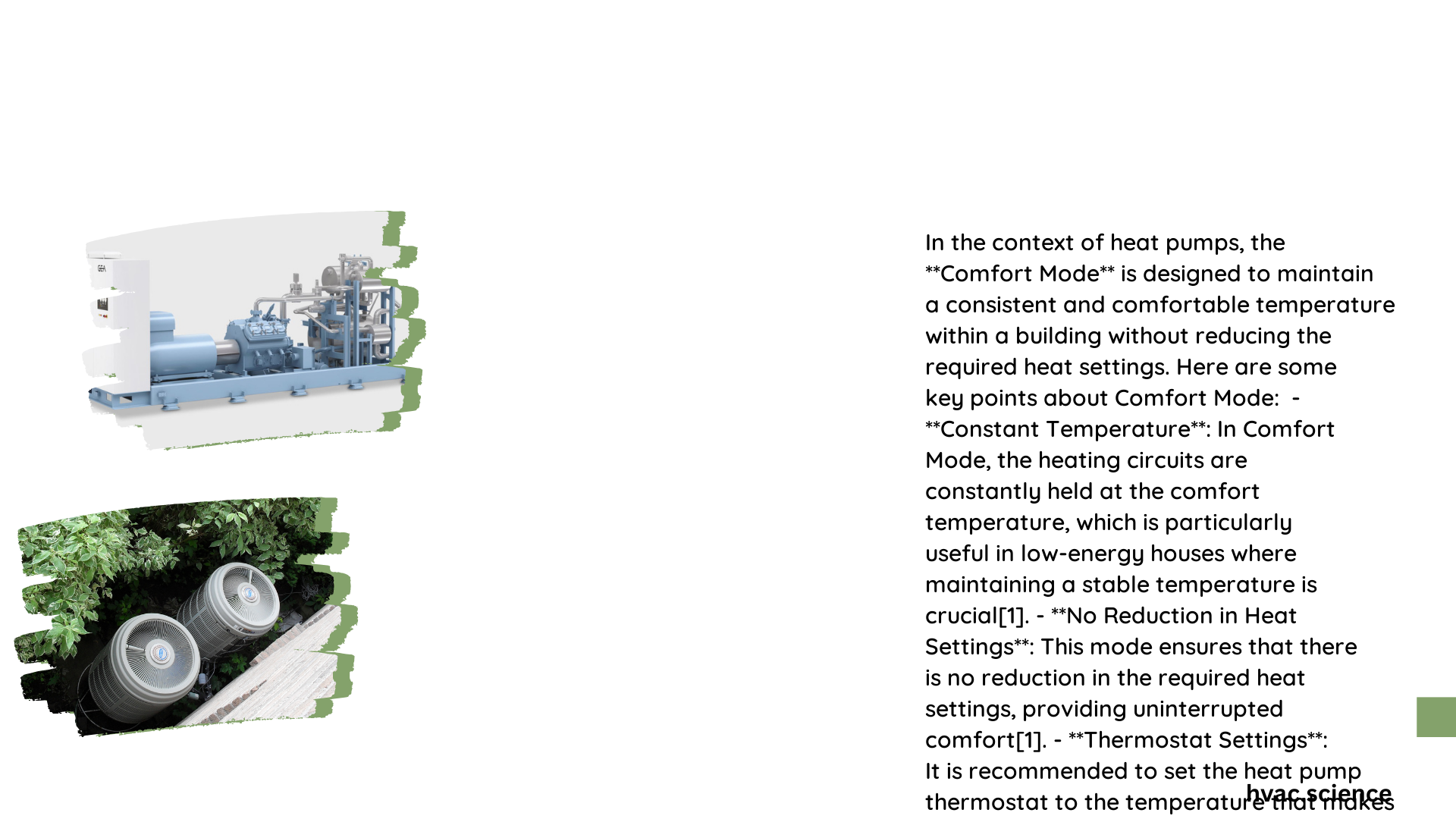Heat pump comfort mode is an advanced feature in modern heat pump systems that optimizes indoor climate control for maximum comfort and energy efficiency. This mode balances temperature, humidity, and air quality while minimizing energy consumption. Heat pump comfort mode adapts to changing conditions, providing consistent comfort year-round. It offers precise temperature control, improved air quality, and significant energy savings compared to traditional HVAC systems.
What is Heat Pump Comfort Mode?
Heat pump comfort mode is a specialized operating setting designed to maximize user comfort while maintaining energy efficiency. This mode utilizes advanced algorithms and sensors to continuously adjust the heat pump’s performance based on indoor and outdoor conditions. The primary goal is to create an ideal living environment by balancing temperature, humidity, and air quality.
How Does Heat Pump Comfort Mode Work?
Heat pump comfort mode operates by:
- Monitoring indoor temperature and humidity levels
- Adjusting fan speeds and compressor operation
- Balancing heating and cooling cycles
- Optimizing airflow distribution
- Maintaining consistent temperature throughout the home
This intelligent operation ensures that your living space remains comfortable regardless of external weather conditions.
What Are the Benefits of Using Heat Pump Comfort Mode?

Heat pump comfort mode offers several advantages over standard operation:
- Enhanced temperature stability
- Improved humidity control
- Better air quality
- Reduced energy consumption
- Quieter operation
- Extended equipment lifespan
How Does Comfort Mode Improve Indoor Air Quality?
Comfort mode contributes to better indoor air quality through:
- Consistent air circulation
- Humidity balancing
- Efficient air filtration
- Reduction of airborne pollutants
- Prevention of mold and mildew growth
These factors combine to create a healthier and more comfortable living environment.
What Are the Recommended Settings for Heat Pump Comfort Mode?
To maximize the benefits of heat pump comfort mode, consider the following settings:
| Setting | Recommended Range |
|---|---|
| Temperature | 68°F to 72°F (20°C to 22°C) |
| Humidity | 30% to 50% |
| Fan Speed | Auto or Low |
| Air Filter | Clean and replace regularly |
How Should You Adjust Settings for Different Seasons?
Seasonal adjustments can help optimize comfort and efficiency:
- Summer: Set temperature slightly higher (74°F to 78°F) to reduce cooling load
- Winter: Set temperature slightly lower (66°F to 70°F) to reduce heating demand
- Spring/Fall: Use ‘Auto’ mode to seamlessly switch between heating and cooling
How Energy Efficient is Heat Pump Comfort Mode?
Heat pump comfort mode is highly energy-efficient, often surpassing traditional HVAC systems in performance. The efficiency is measured by the Seasonal Energy Efficiency Ratio (SEER) for cooling and Heating Seasonal Performance Factor (HSPF) for heating.
What SEER and HSPF Ratings Should You Look For?
For optimal efficiency, consider heat pumps with:
- SEER rating of 18 or higher
- HSPF rating of 10 or higher
These ratings indicate superior energy performance and potential for significant cost savings.
How Much Can You Save with Heat Pump Comfort Mode?
Energy savings with heat pump comfort mode can be substantial:
- Up to 50% reduction in energy costs compared to traditional systems
- Annual savings of $300 to $800 for an average household
- Payback period of 5-7 years for system upgrade costs
What Challenges Might You Face with Heat Pump Comfort Mode?
While heat pump comfort mode offers numerous benefits, there are potential challenges to consider:
- Initial installation costs
- Learning curve for optimal settings
- Potential for reduced efficiency in extreme temperatures
- Need for regular maintenance
How Can You Overcome These Challenges?
To address these challenges:
- Consider long-term savings when evaluating installation costs
- Consult with HVAC professionals for optimal settings
- Use supplemental heating in extremely cold climates
- Schedule regular maintenance and filter replacements
How to Maintain Your Heat Pump for Optimal Comfort Mode Performance?
Proper maintenance is crucial for ensuring your heat pump’s comfort mode performs optimally:
- Clean or replace air filters monthly
- Keep outdoor unit clear of debris
- Schedule annual professional inspections
- Clean indoor vents and registers regularly
- Monitor system performance and address issues promptly
What Are the Signs That Your Heat Pump Needs Maintenance?
Watch for these indicators that your heat pump may need attention:
- Inconsistent temperatures
- Unusual noises during operation
- Increased energy bills
- Poor airflow from vents
- Frequent cycling on and off
Addressing these issues promptly can help maintain the efficiency and effectiveness of your heat pump’s comfort mode.
Conclusion
Heat pump comfort mode offers a sophisticated approach to home climate control, balancing comfort, air quality, and energy efficiency. By understanding its operation, optimizing settings, and maintaining your system, you can enjoy a consistently comfortable home environment while minimizing energy costs. As heat pump technology continues to advance, comfort mode features are likely to become even more refined, further enhancing the user experience and environmental benefits.
References:
1. https://www.cleanairactheatingandac.com/blog/heat-pump-service/maximizing-home-comfort-how-a-new-heat-pump-can-cool-your-home-better/
2. https://www.greenhomeheatpumps.co.uk/the-effect-of-heat-pumps-on-indoor-air-quality
3. https://bearshomesolutions.com/heat-pump-operation-and-benefits-explained/
